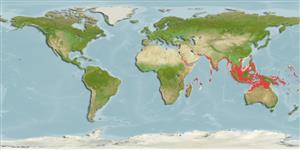Elasmobranquios (tiburones y rayas) (sharks and rays) >
Torpediniformes (Electric rays) >
Narcinidae (Numbfishes)
Etymology: Narcine: Greek, narke = numbness (Ref. 45335).
Environment: milieu / climate zone / depth range / distribution range
Ecología
marino demersal. Tropical
Indo-West Pacific: off Pakistan to the Gulf of Thailand.
Length at first maturity / Tamaño / Peso / Age
Maturity: Lm ?, range 14 - ? cm
Max length : 22.0 cm TL macho / no sexado; (Ref. 9912)
Found in continental waters, both inshore and offshore (Ref. 9912). Biology little known (Ref. 9912).
Life cycle and mating behavior
Maturities | Reproducción | Spawnings | Egg(s) | Fecundities | Larva
de Carvalho, M.R., L.J.V. Compagno and P.R. Last, 1999. Narcinidae. Numbfishes. p. 1433-1442. In K.E. Carpenter and V.H. Niem (eds.) FAO species identification guide for fishery purposes. The living marine resources of the Western Central Pacific. Vol. 3. Batoid fishes, chimaeras and bony fishes. Part 1 (Elopidae to Linophrynidae). FAO, Rome. (Ref. 9912)
IUCN Red List Status (Ref. 130435)
Human uses
Herramientas
Special reports
Download XML
Fuentes de Internet
Estimates based on models
Preferred temperature (Ref.
123201): 23.7 - 28.6, mean 27.4 °C (based on 1072 cells).
Phylogenetic diversity index (Ref.
82804): PD
50 = 0.5000 [Uniqueness, from 0.5 = low to 2.0 = high].
Bayesian length-weight: a=0.01175 (0.00476 - 0.02897), b=2.88 (2.66 - 3.10), in cm total length, based on LWR estimates for this (Sub)family-body shape (Ref.
93245).
Nivel trófico (Ref.
69278): 3.1 ±0.3 se; based on size and trophs of closest relatives
Resiliencia (Ref.
120179): Bajo, población duplicada en un tiempo mínimo de 4.5-14 años (Assuming fecundity<100).
Fishing Vulnerability (Ref.
59153): Low vulnerability (12 of 100).
